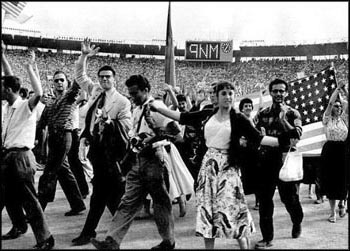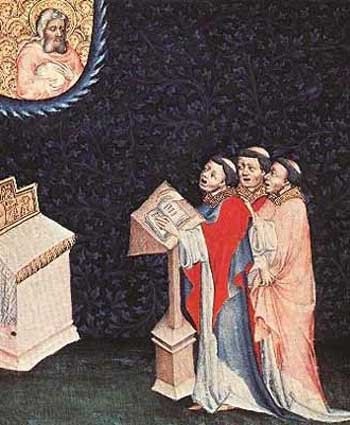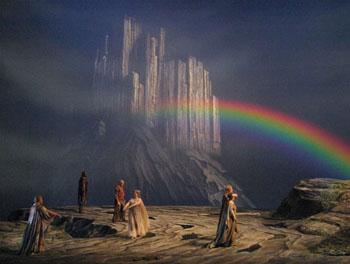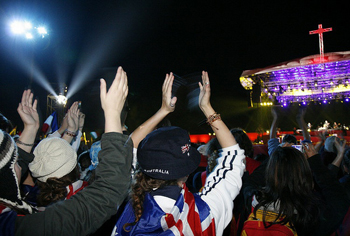 |
Art & Architecture
Modern Music’s Harm for Youth
Lyle J. Arnold, Jr.
Military training has its quintessential effect on youth. During war, older men are trained in the military arts, but only when a young mind is "unobstructed by age can you get the recruit to like it." (1) In this affirmation of the US Marine Corps, there is a universal law. It applies to changing the customs, habits and actual way of being of youth, for good or for bad. And those who form the youth know that music plays an important role in the formation of their souls. And for the last half century the music being written specifically for them is of a genre that can make them neurotic, mentally deteriorated and even retarded.

Americans participating in a Youth Festival in Lenin Square, Moscow, in 1957 |
The Communists understood this well when they promoted rock music for the American youth:
1946: Welcome to the "World Youth Festival," USA; Aegis: Communist Party. Mission: Communist propaganda. Method: music. (2)
Forty years later, we find the progressivists doing the same:
1985: Welcome to "The World Youth Day;" Aegis: John Paul II / Conciliar Church. Mission: Progressivist activism. Method: music. (3)
From sacral to profane
Aristotle explained the destructiveness of certain kinds of music. He held that emotions are produced by melody and rhythm, and that music has the power to form character. The Greek philosopher affirmed that musical arrangements are so important that "the various modes may be distinguished by their effects on character. One, for example, fosters melancholy, another effeminacy; one encourages abandonment, another, self-control, another, enthusiasm, and so on." (4)

Medieval monks honoring God with the Gregorian chant |
We can confirm that music reflected the spirit of the epochs of Western Civilization, some for the good, many others for the bad. The Gothic period – from the 12th century to 15th century – undoubtedly produced the highest form of music. It was based on vocal Gregorian chant and polyphonic, and was directly or indirectly sacred in character.
From that point on, music began to divorce itself from the sacred, whether in its use of pitch, harmony or timbre.
An excellent example of how the Revolution transships the sacred into the modern can be found in Paul Hindemith's symphony Mathis der Maley, composed in 1934. Hindemith drew his inspiration for his piece from the painting Entombment of Our Lord (1510) by the still medieval painter Matthias Grunewald. The painting follows the medieval style and piously reflects Our Lord's body after the Passion. Yet Hindemith’s compositions are in the ultramodern motif.
Descent of music
In the centuries that followed the Middle Ages, the spirit of the Revolution is patent in the musical arrangements. Exulting in a revived pagan Humanism, the Renaissance period relegated "the Church, the supernatural, and the moral values of Religion to a secondary plane." (5)
It was followed by the Baroque period. “Barroco” from the Portuguese means "misshapen pearl," a negative description of the ultra-heavy ornamentation of its style either in architecture or in music. After this brief revival, music was consistently imbued with the spirit of the Revolution. The 18th century’s delicate and mediocre Rococo music was a reaction against the grandeur of the Baroque.
Philosophic obtrusiveness conjoined itself with musical forms in the following Neo-Classical/Romantic period. The 19th century Romantic period exaggerated personal emotions to express supposedly sublime realities. It also dived into mythology under the pretext of entering an elevated dream world, as Wagner did.

The mythical scene of the entry of the gods into Valhalla in Wagner's opera Das Reingold - The gold of the Rhine |
Other romantic geniuses include Paganini, known for his virtuosity, and Lizt, who aptly described to his listener the episodes he was putting to music. The most famous composer of Impressionism is considered to be Debussy, whose music is characterized for its turbulence, chaotic mood and sensual orchestration.
The chaos and sensuality initiated by Debussy would result in a complete musical crash, beginning in the 20th century with jazz followed by other types with increased dissonance.
The next period music - the swing and big-band - could almost be called docile when compared to what followed. Modem jazz increased the tempo exponentially, producing in the nervous system an unnatural tension that acted as a catalyst for losing one's control.
Communism & Cultural Revolution
As noted above, in 1946 the American Communist Party and affiliates organized youth festivals and began to promote modern music for our nation’s youth, with the aim of fostering in them a revolutionary spirit and turning them into anti-American Marxists. As the Cold War progressed, it became clear to political leaders that the "World Youth Festivals" were organized by Communists.
For example, the California Senate Fact-finding Subcommittee on Un-American Activities released a study about the “People's Songs” promoted at these festivals. It stated, “People's Songs, Inc. is now writing songs and plays, promoting choruses and schools for Communist fronts... It staged a benefit for the Communist Party in New York City on November 30, 1946. Advertisements and press notices for its activities are to be found in the Daily Worker... People's Songs have sent delegated representatives to the Prague conference of the Communist World Youth Festival.” (6)
This action was called subversive by the US Attorney General. That warning, however, did not stop the flood of rock music that swept the music scene with the Cultural Revolution.
A part of the Cultural Revolution was the introduction of rock music. It started before in the ‘50s, but in the ‘60s it came to dominate the American youth scene, principally after the Berkeley revolt and Woodstock. On the international scene, the change was led by the Beatles and the 1970 Isle of Wight Festival, England, as well as the Sorbonne Revolution in France in 1968.
Catholic Woodstocks
Now, turning to the Catholic "World Youth Days," we see the same revolutionary messages of the cultural revolution and rock music being accepted and “blessed” within the walls of the Church herself. ”The Enemy within the Gates” is what our Catholic youth are facing in the WYDs.

The WYD-2008 in Sydney opened with a rock concert |
The music that invades the souls of the youth at these events is labeled as flamboyant rock, rap, and jive. The WYD itself is called a festival. A slew of rock/pop shows are scheduled to keep the youth entertained, not rarely performed by bands of Franciscans, Dominicans or other monks. These shows feature everything from African drums and Brazilian rock to hip hop Christian pop rock and whirling dervishes. An adjective has been coined to describe this kind of music, “menticide," murder of the mind. (7)
The progressivists were not content with inculturating popular music into the parish pews at Sunday Masses. Following the tactic of Communist World Festivals, the Conciliar Church took the opportunity to promote the same evil in the souls of youth on a massive scale with the WYDs. In 2010, the “Youth Anthem” chosen to welcome Benedict XVI to the UK was a rap song.
How much more filth can come through the window that John XXIII opened to the modern world with Vatican II? May Our Lady of Prompt Succor hear our prayers to quickly intervene and put an end to this progressivist Revolution.
1. "War," U.S. Marine Corps training, Canadian National Films, 1983, Discovery Channel, by Gwynne Dyer.
2. David A. Noebel, The Marxist Minstrels — A Handbook on Communist Subversion of Music, Tulsa: American Christian College Press, 1974, p.126.
3. Marian T. Horvat, "WYD at Cologne: No Sign that the Tide has Turned," Tradition in Action.
4. Aristotle, Politics, 1339a; 1340 a, b.
5. Revolution & Counter-Revolution, Plinio Correa de Oliveira, The Foundation for a Christian Civilization, 1980, p. 30.
6. Edward Hunter, Brainwashing, Pyramid Bks,1961, p. 6.
7. Coined by Dr. Joost A.M. Meerloo, a Dutch psychiatrist

Posted June 6, 2012

Related Topics of Interest
 WYD at Cologne: No Sign that the Tide Has Turned WYD at Cologne: No Sign that the Tide Has Turned
 Nun Caught Up in Spirit of WYD Nun Caught Up in Spirit of WYD
 Stations of the Cross Changed for WYD-2008 Stations of the Cross Changed for WYD-2008
 Free Love under the Church's Protection Free Love under the Church's Protection
 Another Woodstock in Toronto Another Woodstock in Toronto
 Cultural Revolution under the Church's Umbrella Cultural Revolution under the Church's Umbrella
 WYD: Heading Toward a ‘Sacred’ Brothel? WYD: Heading Toward a ‘Sacred’ Brothel?
 Woodstock Style at the Sydney WYD Woodstock Style at the Sydney WYD
 And the Woodstock Continues... And the Woodstock Continues...

Related Works of Interest
|
|
Art & Architecture | Hot Topics | Home | Books | CDs | Search | Contact Us | Donate

© 2002-
Tradition in Action, Inc. All Rights Reserved
|
 |

|